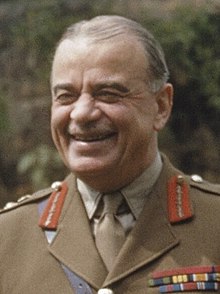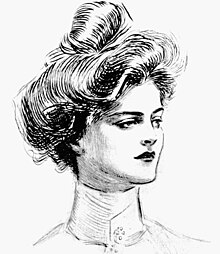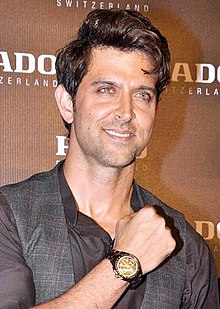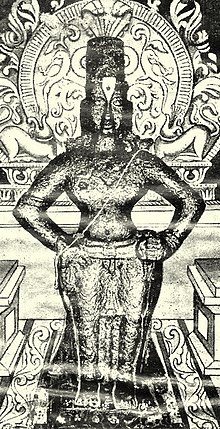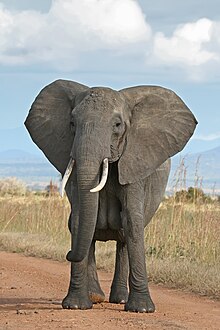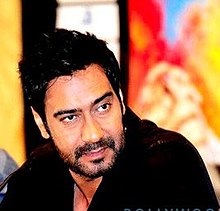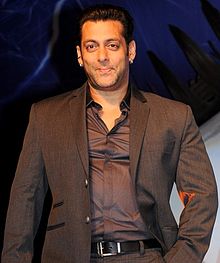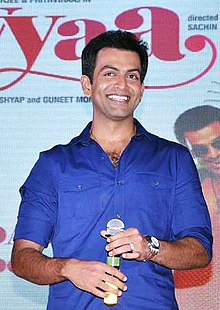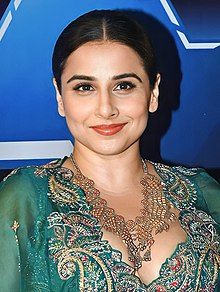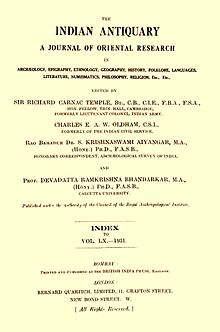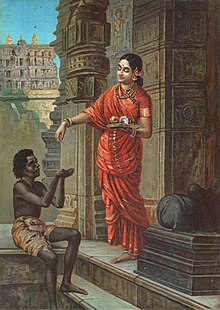Portal:India
Introduction


India, officially the Republic of India (ISO: Bhārat Gaṇarājya), is a country in South Asia. It is the seventh-largest country by area; the most populous country with effect from June 2023; and from the time of its independence in 1947, the world's most populous democracy. Bounded by the Indian Ocean on the south, the Arabian Sea on the southwest, and the Bay of Bengal on the southeast, it shares land borders with Pakistan to the west; China, Nepal, and Bhutan to the north; and Bangladesh and Myanmar to the east. In the Indian Ocean, India is in the vicinity of Sri Lanka and the Maldives; its Andaman and Nicobar Islands share a maritime border with Thailand, Myanmar, and Indonesia. (Full article...)
Selected pictures
Jahanpanah was the fourth medieval city of Delhi established in 1326–1327 by Muhammad bin Tughlaq (1325–51), of the Delhi Sultanate. To address the constant threat of the Mongols, Tughlaq built the fortified city of Jahanpanah (meaning in Persian: "Refuge of the World") subsuming the Adilabad fort that had been built in the 14th century and also all the establishments lying between Qila Rai Pithora and Siri Fort. Neither the city nor the fort has survived. Many reasons have been offered for such a situation. One of which is stated as the idiosyncratic rule of Mohammed bin Tughlaq when inexplicably he shifted the capital to Daulatabad in the Deccan and came back to Delhi soon after.
The ruins of the city's walls are even now discerned in the road between Siri to Qutub Minar and also in isolated patches behind the Indian Institute of Technology (IIT), in Begumpur, Khirki Masjid near Khirki village, Satpula and many other nearby locations; at some sections, as seen at Satpula, the fort walls were large enough to have few inbuilt storerooms to stack provisions and armory. The mystery of the city's precincts (complex) has unfolded over the years with later day excavations revealing a large number of monuments in the villages and colonies of South Delhi. Due to the compulsions of urban expansion of the Capital City of Delhi, Jahanpanah is now part of the upscale urban development of South Delhi. The village and the wealth of ruins scattered all around are now enclosed by South Delhi suburbs of Panchshil Park South, Malviya Nagar, Adchini, the Aurobindo Ashram, Delhi branch and other smaller housing colony developments. It is hemmed in the North–South direction between the Outer Ring Road and the Qutb Complex and on the east–west direction by the Mehrauli road and the Chirag Delhi road, with Indian Institute of Technology located on the other side of the Mehrauli road as an important landmark. (Full article...)
The 2014 Indian Super League Final was an association football match between the Kerala Blasters and ATK played on 20 December 2014, at the DY Patil Stadium in Navi Mumbai. The match was the final match to determine the inaugural champion of the Indian Super League for the 2014 season.
The Kerala Blasters had qualified for the final through defeating the first-place regular season side, Chennaiyin, 4–3 on aggregate. ATK qualified after defeating Goa in a penalty shoot-out 4–2. Prior to the final, during the regular season, both sides played to a 1–1 draw at the Salt Lake Stadium while Kerala Blasters won the return match 2–1 in Kochi. (Full article...)
The Khalji Revolution, alternatively spelled the Khilji Revolution, marked a military coup and a period of political and societal transformation in the Delhi Sultanate. It unfolded following the death of Mamluk sultan Balban and the subsequent incapacity of his successors to effectively govern the Delhi Sultanate. The upheaval commenced and concluded in 1290 when Jalaluddin Khalji seized absolute power, toppling the Mamluks and inaugurating the rule of the Khalji dynasty.
After Balban's death, his underage grandson Qaiqabad ascended the throne. A poor governor, Qaiqabad later fell ill and became paralyzed, leading to the succession of his son, Shamsuddin Kayumars. Amidst this upheaval, factions arose within the Mamluk court, with the Turkic faction led by Aitmar Surkah facing off against the Khalji faction, led by Jalaluddin Khalji. (Full article...)
Mandodari (Sanskrit: मंदोदरी, Mandodarī, lit. "soft-bellied";) was the queen consort of Ravana, the king of Lanka, according to the Hindu epic Ramayana. The Ramayana describes her as beautiful, pious, and righteous. She is extolled as one of the Panchakanya, the recital of whose names is believed to dispel sin.
Mandodari was the daughter of Mayasura, the King of the Asuras (demons), and the apsara (celestial nymphs) Hema. She marries Ravana and bears three sons: Meghanada (Indrajit), Atikaya and Akshayakumara. According to some Ramayana adaptations, Mandodari is also the mother of Rama's wife Sita, who is infamously kidnapped by Ravana. Despite her husband's faults, Mandodari loves him and advises him to follow the path of righteousness. She repeatedly advises Ravana to return Sita to Rama, but her advice falls on deaf ears. Her love and loyalty to Ravana are praised in the Ramayana. (Full article...)
Karl Marx in Kalbadevi was successful and has had hundreds of performances, but received mixed reviews from theatre critics. It was praised for Puranik's performance and for presenting complex ideas simply but criticised for its script. (Full article...)
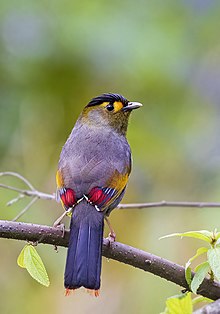
The Bugun liocichla (Liocichla bugunorum) is a passerine bird species from the family Leiothrichidae closely related to the Emei Shan liocichla. First spotted in 1995 in Arunachal Pradesh, India, it was described as a new species in 2006. The description was made without the collection of a type specimen as they were too few to risk killing one. It is thought to be an endangered species, with a small population, and a very restricted distribution range within which commercial development threatens the habitat. (Full article...)
Pelli Chesi Choodu deals with the negative effects of the dowry system in India through the marital life of Venkata Ramana (Rama Rao) and Ammadu (Varalakshmi). The film's production began after the release of Vijaya Productions' Pathala Bhairavi (1951). Marcus Bartley was recruited as the cinematographer and the film was edited by C. P. Jambulingam and M. S. Money. Ghantasala composed the film's music. (Full article...)
Aishwarya Rai Bachchan (pronounced [ɛːʃʋəɾjᵊ ɾɑːj ˈbətːʃən]; née Rai; born 1 November 1973) is an Indian actress who is primarily known for her work in Hindi and Tamil films. Rai won the Miss World 1994 pageant and later established herself as one of the most-popular and influential celebrities in India. She has received numerous accolades for her acting, including two Filmfare Awards. In 2004, Time magazine named her one of the 100 most influential people in the world. In 2009, the Government of India honoured her with the Padma Shri and in 2012, the Government of France awarded her with the Order of Arts and Letters. In the 2000s and 2010s, media often called her "the most beautiful woman in the world".
While in college, Rai modelled and appeared in several television commercials, and entered the Miss India pageant, in which she was placed second. She was then crowned Miss World 1994, made her acting debut in Mani Ratnam's 1997 Tamil film Iruvar and had her Hindi film debut in Aur Pyaar Ho Gaya that year. Her first commercial success was the Tamil romantic drama Jeans (1998), which at the time was the most expensive Indian film. She achieved wider success and won two Filmfare Awards for Best Actress for her performances in Sanjay Leela Bhansali's romantic dramas Hum Dil De Chuke Sanam (1999) and Devdas (2002). (Full article...)

The Great Renunciation or Great Departure (Sanskrit: mahābhiniṣkramaṇa; Pali: mahābhinikkhamana)
is the traditional term for the departure of Gautama Buddha (c. 563–c. 483 BCE) from his palace at Kapilavastu to live a life as an ascetic (Sanskrit: śrāmaṇa, Pali: sāmaṇa). It is called the Great Renunciation because it is regarded as a great sacrifice. Most accounts of this event can be found in post-canonical Buddhist texts from several Buddhist traditions, which are the most complete. These are, however, of a more mythological nature than the early texts. They exist in Pāli, Sanskrit and Chinese language.
According to these accounts, at the birth of Prince Siddhārtha Gautama, the Buddha-to-be, Brahmanas predicted that he would either become a world teacher or a world ruler. To prevent his son from turning to religious life, Prince Siddhārtha's father and rāja of the Śākya clan Śuddhodana did not allow him to see death or suffering, and distracted him with luxury. During his childhood, Prince Siddhārtha had a meditative experience, which made him realize the suffering (Sanskrit: duḥkha, Pali: dukkha) inherent in all existence. He grew up and experienced a comfortable youth. But he continued to ponder about religious questions, and when he was 29 years old, he saw for the first time in his life what became known in Buddhism as the four sights: an old man, a sick person and a corpse, as well as an ascetic that inspired him. Shortly after, Prince Siddhārtha woke up at night and saw his female servants lying in unattractive poses, which shocked the prince. Moved by all the things he had experienced, the prince decided to leave the palace behind in the middle of the night against the will of his father, to live the life of an wandering ascetic, leaving behind his just-born son Rāhula and wife Yaśodharā. He traveled to the river Anomiya with his charioteer Chandaka and horse Kaṇṭhaka, and cut off his hair. Leaving his servant and horse behind, he journeyed into the woods and changed into monk's robes. Later, he met King Bimbisāra, who attempted to share his royal power with the former prince, but the now ascetic Gautama refused. (Full article...)
Alchi Monastery (Tibetan: ཨ་ལྕི་ཆོས་འཁོར།) or Alchi Gompa (Tibetan: ཨ་ལྕི་དགོམ་པ།, also Alci) is a Tibetan Buddhist monastery, known more as a monastic complex (chos-'khor) of temples in Alchi village in the Leh District, under the Ladakh Autonomous Hill Development Council of the Ladakh Union Territory. The complex comprises four separate settlements in the Alchi village in the lower Ladakh region with monuments dated to different periods. Of these four hamlets, Alchi monastery is said to be the oldest and most famous. It is administered by the Likir Monastery. It is 60 west of Leh on Leh-Kargil Highway.
Alchi is also part of the three villages (all in lower Ladakh region) which constitute the ‘Alchi group of monuments’; the other two villages adjoining Alchi are the Mangyu and Sumda Chun. The monuments in these three villages are stated to be of "unique style and workmanship’, but the Alchi monastic complex is the best known. (Full article...)
Rao's research focused on peripatetic, agrarian populations in Afghanistan, France, Jammu, Kashmir, and western Rajasthan. Rao researched the impact of the conflict in Kashmir on the environment and lives of people. Her 1982 work, Les Ġhorbat d'Afghanistan. Aspects Économiques d'un Groupe Itinérant 'Jat, researched the ethnic makeup and local economy of Afghanistan. Her book Autonomy: Life Cycle, Gender, and Status among Himalayan Pastoralists received the 1999 Choice award. ('Full article...)
Saif Ali Khan (pronounced [ˈsæːf əˈli xaːn]; born Sajid Ali Khan Pataudi; 16 August 1970) is an Indian actor and film producer who primarily works in Hindi films. Current head of the Pataudi family, he is the son of actress Sharmila Tagore and cricketer Mansoor Ali Khan Pataudi. Khan has won several awards, including a National Film Award and seven Filmfare Awards, and received the Padma Shri, the fourth highest Indian civilian award in 2010.
Khan made his acting debut in Parampara (1993), and had success in the multi-starrers Yeh Dillagi (1994), Main Khiladi Tu Anari (1994), Kachche Dhaage (1999) and Hum Saath-Saath Hain (1999). In the 2000s, he gained praise and won multiple awards for his roles in the romantic comedies Dil Chahta Hai (2001) and Kal Ho Naa Ho (2003), and had success as a solo male star in the romances Hum Tum (2004), Parineeta, Salaam Namaste (both 2005) and Ta Ra Rum Pum (2007). (Full article...)
The Beatles had intended to join the Maharishi in India soon after attending his seminar in Bangor, Wales in late August 1967. Their attendance at the seminar was cut short by the death of their manager Brian Epstein, after which they committed to making the television film Magical Mystery Tour. Harrison and John Lennon were convinced of the merits of TM and became spokesmen for the Maharishi's Spiritual Regeneration Movement, as he gained international prominence as the guru to the Beatles. The band members arrived in India in mid-February 1968, along with their wives, girlfriends, assistants, and numerous reporters. They joined a group of 60 training to be TM teachers; among the other celebrity meditators were musicians Donovan, Mike Love and Paul Horn, and actress Mia Farrow. While there, Lennon, Paul McCartney and Harrison wrote many songs, and Ringo Starr finished writing his first. Eighteen were recorded for The Beatles ("the White Album"), two others appeared on the Abbey Road album, and others were used for various solo projects. (Full article...)
Written by Samudrala Sr., Kannadasan, and Murugadasa, Tenali Ramakrishna narrates the story of the 14th century Telugu and Sanskrit poet and scholar of the same name, and his life as a member of the court of Krishnadevaraya, the king of the Vijayanagara Empire. Using his wits, Ramakrishna manages to save Krishnadevaraya from attacks by the Bahmani Sultanate, which tries to invade the Vijayanagara Empire. The rest of the film is about Ramakrishna's efforts to save Krishnadevaraya from courtesan Krishnasani, a spy, and convincing Emperor Babur against extending support to the Sultanate in the war. (Full article...)
Thiruvilaiyadal was inspired by the Thiruvilaiyadal Puranam: a collection of sixty-four Shaivite devotional, epic stories, written in the 16th century by Paranjothi Munivar, which record the actions (and antics) of Shiva on Earth in a number of disguises to test his devotees. Thiruvilaiyadal depicts four of the stories. The first is about the poets Dharumi and Nakkeerar; the second concerns Dhakshayani. The third recounts how Shiva's future wife, Parvati, is born as a fisherwoman; Shiva, in the guise of a fisherman, finds her and marries her. The fourth story is about the singers Banabhathirar and Hemanatha Bhagavathar. (Full article...)
Akshata Narayana Murty (/ˈʌkʃʌtɑː nɑːˈrɑːjʌnʌ ˈmuːrθi/; born 25 April 1980) is an Indian heiress, businesswoman, fashion designer, and venture capitalist. She is the wife of former Prime Minister of the United Kingdom Rishi Sunak and the daughter of N. R. Narayana Murthy, a founder of the Indian multinational IT company Infosys, and Sudha Murty. She holds a 0.93 per cent stake in Infosys, along with shares in several other British businesses.
Since 2009 she has been married to Rishi Sunak, the former Prime Minister of the United Kingdom and leader of the Conservative Party from 2022 to 2024. He also served as Chancellor of the Exchequer from 2020 to 2022 in Prime Minister Boris Johnson's cabinet. According to the Sunday Times Rich List, Murty and Sunak hold the 245th rank for the richest people in Britain as of 2024[update], with a combined wealth of £651 million (US$827 million). In 2022, her personal wealth became the topic of British media discussion in the context of her claim of non-domiciled status, an arrangement seen as benefiting the "super rich". Murty later voluntarily renounced the fiscal benefits from her non-domiciled status. (Full article...)
Puri, also known as, Jagannath Puri, (Odia: [ˈpuɾi] ) is a coastal city and a municipality in the state of Odisha in eastern India. It is the district headquarters of Puri district and is situated on the Bay of Bengal, 60 kilometres (37 mi) south of the state capital of Bhubaneswar. It is home to the 12th-century Jagannath Temple and is one of the original Char Dham pilgrimage sites for Hindus.
Puri known by several names since ancient times, and was locally known as "Sri Kshetra" and the Jagannath temple is known as "Badadeula". Puri and the Jagannath Temple were invaded 18 times by Muslim rulers, from the 7th century AD until the early 19th century with the objective of looting the treasures of the temple. Odisha, including Puri and its temple, were part of British India from 1803 until India attained independence in August 1947. Even though princely states do not exist in India today, the heirs of the House of Gajapati still perform the ritual duties of the temple. The temple town has many Hindu religious mathas or monasteries. (Full article...)
News
- 23 August 2024 – 2024 India–Bangladesh floods
- At least 23 people are killed and more than 4.5 million people are affected by floods caused by heavy rains in eastern Bangladesh. (Al Jazeera)
- 23 August 2024 –
- Twenty-seven people are killed and 16 more injured when a bus carrying Indian pilgrims on the Prithvi Highway in Nepal crashes. (AP)
- 23 August 2024 – Peace negotiations in the Russian invasion of Ukraine, India–Ukraine relations
- During a meeting in Kyiv, Ukraine, Prime Minister of India Narendra Modi urges Ukrainian President Volodymyr Zelenskyy to end the Russo-Ukrainian War, and volunteers to act as a mediator in talks between Zelenskyy and Russia. In a later national address, Zelenskyy thanked Modi but stated that it is necessary for India to respect international law as well as Ukraine's territorial integrity and sovereignty. (Reuters)
- 21 August 2024 – Atchutapuram pharmaceutical factory explosion
- At least seventeen workers are killed and 41 others are injured, many from severe chemical burns, in an explosion at a pharmaceutical facility in Anakapalli, Andhra Pradesh, India. (Indian Express) (NDTV)
- 13 August 2024 – 2024 Kolkata rape and murder incident
- Thousands of doctors and university students participate in walkouts and protests against sexual violence in cities across India after the alleged rape and murder of a female medical trainee in Kolkata last week. (DW)
Did you know...
- ... that Gandhi's statue in the Indian parliament is frequently used as a protest site by members of parliament?
- ... that after its merger with India, the last raja of Jubbal State joined the Indian Foreign Service?
- ... that Indian field hockey player Sukhbir Singh Gill continued to play professionally after being diagnosed with a brain tumor in 2006?
- ... that according to Indian chef Imtiaz Qureshi, who is credited with reviving the cooking tradition of dum pukht, all biryanis are pulaos?
- ... that Indian harmonium player Appa Jalgaonkar stopped singing due to puberty?
- ... that according to the book Price of the Modi Years, the popularity of Indian prime minister Narendra Modi does not depend on his performance?
Topics related to India
Timeline of Indian history, Indus Valley Civilisation, Dholavira, Science and technology in ancient India, Meluhha, Aryan invasion theory, Out of India theory, Greek conquests in India, Indian maritime history, Maurya Empire, Ashoka, Shunga Empire, Hoysala Empire, Vijayanagara, Satavahana dynasty, Indo-Greek Kingdom, Indo-Scythians, Indo-Parthian Kingdom, Kushan Empire, Western Satraps, Gupta Empire, Chola dynasty, Pala Empire, Islamic incursions in India, Mughal Empire, Maratha Empire, British Raj, East India Company, Governor-General, Viceroy, War of Independence, 1857, Indian independence movement, Indian National Army, Azad Hind, Quit India Movement, Partition of India, History of Republic of India, Non-Aligned Movement, Sino-Indian War, Indo-Pakistani War of 1947–1948, Indo-Pakistani War of 1965, Indo-Pakistani War of 1971, Kargil War, 2001–02 India–Pakistan standoff, Military, Demographic
Law, Hindu law, Constitution, Political parties (Indian National Congress, Bharatiya Janata Party), Foreign relations, Elections, Political divisions, Reservation in India
Government agencies, Legislative branch (Lok Sabha, Rajya Sabha) Executive branch (President & Vice President, Prime Minister & Deputy Prime Minister, Cabinet Ministers, Cabinet Secretary, Election Commission, Foreign Minister; Law enforcement: CBI, CID, Intelligence: IB, RAW), Directorate General of Income Tax Investigation Judicial branch (Supreme Court), Armed Forces (Army, Navy, Air Force, Border Security Force, Coast Guard)
Himalayas, Western Ghats, Eastern Ghats, Indo-Gangetic Plain, Deccan Plateau, Thar Desert, Ganges, Rann of Kutch, Brahmaputra River, Northeast India; Mountains, Valleys, Islands, Rivers; States and union territories, Cities, Districts, Regions, Fauna, Flora
Rupee, Bombay Stock Exchange, National Stock Exchange, Standard of living, Companies, Reserve Bank of India, Energy policy (Solar, Wind, Nuclear), Tourism, Transport (Expressways, Rail transport, Auto rickshaw),
Languages, Standard of living, Religion
Music (Carnatic, Hindustani, Indi-pop), Dance, Languages, Literature, Architecture, Film & TV, Cuisine, Holidays, Folklore, Education, Media, Indian martial arts
Indian Council of Agricultural Research (ICAR), Indian Institute of Astrophysics, National Centre for Software Technology, AIIMS, IISc, IIT, NIT, BITS-Pilani, INRegistry, Indian numbering system, Indian Space Research Organisation, National Internet Exchange of India, ICRISAT, International Institute of Information Technology, Hyderabad
Indian English, Indian nationality law, Numbering system, Indian Space Research Organisation, Telecommunications, National Highways Development Project, Flag, Vehicle registration plates, Indian nationalism, Metrication in India
Categories
Related portals
Religions in India
Indian Subcontinent
Other countries
Wikipedias in Indian languages
- অসমীয়া (Assamese)
- বাংলা (Bengali)
- भोजपुरी (Bhojpuri)
- বিষ্ণুপ্রিয়া মণিপুরী (Bishnupriya Manipuri)
- गोंयची कोंकणी / Gõychi Konknni (Konkani)
- ગુજરાતી (Gujarati)
- हिन्दी (Hindi)
- ಕನ್ನಡ (Kannada)
- कॉशुर/كشميري (Kashmiri)
- मैथिली (Maithili)
- മലയാളം (Malayalam)
- मराठी (Marathi)
- नेपाली (Nepali)
- नेपाल भाषा
- (Newari)
- ଓଡ଼ିଆ (Odiya)
- ਪੰਜਾਬੀ (Punjabi)
- पालि (Pali)
- संस्कृत (Sanskrit)
- ᱥᱟᱱᱛᱟᱲᱤ (Santali)
- سنڌي (Sindhi)
- தமிழ் (Tamil)
- తెలుగు (Telugu)
- ತುಳು (Tulu)
- اردو (Urdu)
Associated Wikimedia
The following Wikimedia Foundation sister projects provide more on this subject:
-
Commons
Free media repository -
Wikibooks
Free textbooks and manuals -
Wikidata
Free knowledge base -
Wikinews
Free-content news -
Wikiquote
Collection of quotations -
Wikisource
Free-content library -
Wikiversity
Free learning tools -
Wikivoyage
Free travel guide -
Wiktionary
Dictionary and thesaurus






